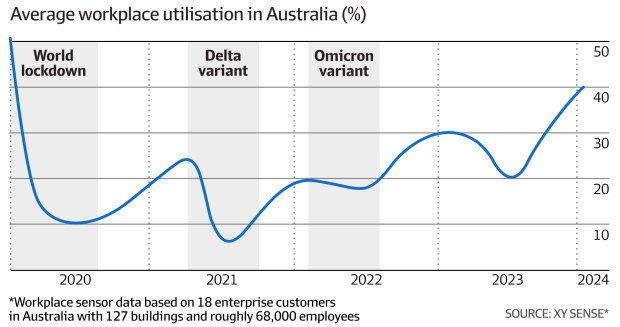Workers rush back to their desks as job fears grow
Rising job security fears linked to the softening economy have driven average office utilisation in Australia to its highest level since the pandemic, contributing to a partial reversal in the rush of city workers moving to the country.
Average workplace utilisation rose from 31 per cent in the final quarter of 2023 to a post-pandemic high of 40 per cent in the first three months of this year, workplace sensor data provided exclusively to The Australian Financial Review shows.

Average office utilisation in Australia has reached its highest level since February 2020, according to XY Sense data. Financial Review
The figure is the highest since the 63.2 per cent recorded in February 2020.
Tuesdays, Wednesdays and Thursdays are the busiest in-office days, while Friday is still the least popular, according to the data from XY Sense, which is based on 18 enterprise customers in Australia that employ roughly 68,000 employees across 127 buildings.
Office utilisation is not the same as occupancy. XY Sense calculates average utilisation for a given workspace as the percentage ratio of total active spaces over total available spaces.
The rush of workers returning to the office has coincided with an uptick in workplace attendance mandates, as well as policies linking time in the office to bonuses and annual performance reviews.
But XY Sense co-founder Alex Birch said these policies had influenced worker behaviour less than rising job security fears in response to the cooling economy.

Productivity Commission chair Danielle Wood. Oscar Colman
“The pendulum has moved towards the employer, and therefore people feel more obliged to go back into work,” Mr Birch said.
Productivity Commission chairwoman Danielle Wood predicted this trend would continue as the jobs market softened.
“When you look at survey data, employers are less likely to perceive productivity benefits in hybrid than workers. There’s quite interesting survey information that suggests for workers, the opportunity to work in a hybrid way in a job is worth about a 7 per cent pay rise,” Ms Wood told the Financial Review.
“Given those differences in views overall, as the labour market softens and employers have more power … we may well see somewhat of a swing in the pendulum.”
Escape to the country unwinds
The recent uptick in office attendance has also partially reversed the pandemic-era “escape to the country” trend, according to new data from economists at the e61 Institute.
The analysis shows the discount that renters get for living in the regions compared to the capital cities appears to be returning to pre-pandemic levels.
The discount fell from at least 15 per cent before the pandemic to less than 5 per cent in 2021 as workers took advantage of lockdowns to live further away.
But since the start of 2023, that trend has unwound and regional living prices have declined sharply.
By the end of last year, the regional discount for renters had doubled to 10 per cent.
The new normal
Aaron Wong, senior research economist at e61, said the data suggested the 2020-22 trend of people moving into the regions was ending “because people are finding they cannot work permanently remotely and they’re having to commute to the city at least part of the time”.
But he denied it was as simple as a return to pre-pandemic conditions.
“We are living in a new normal, which is different from what we experienced in 2020 to 2022 but also different from what we experienced before 2020 – so a third way in between,” he said.
“What we see is people choosing … to have the best of both worlds. They want to access the office but they also want to have access to lifestyle amenities like the bush, like the beach, which is why we see so much demand in places on the urban fringe or inner-regional parts of the states that are close to the capital cities.”
Although regional rents were dropping, rents for homes on the urban fringe – places between 35 and 100 kilometres from a capital city centre – have increased substantially since the pandemic, relative to city centres.
By the end of last year, urban fringes had the same relative difference in rent to the city centre as places that were 15 kilometres to 35 kilometres away, reducing the rent discount for those areas by $1300 a year compared with pre-pandemic.
Although most workers did not have the option to work from home, Mr Wong said the data showed “enough workers have this option that they’re able to shape cities and shape housing markets”.
Subscribe to gift this article
Gift 5 articles to anyone you choose each month when you subscribe.
Subscribe nowAlready a subscriber?
Introducing your Newsfeed
Follow the topics, people and companies that matter to you.
Find out moreRead More
Latest In Workplace
Fetching latest articles